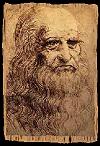|
A popular anecdote, told by Vasari, says the young Leonardo made up a collection of "lizards, crickets, serpents, butterflies, locusts, bats, and various strange creatures of this sort and assembled different parts to create a fearsome and horrible monster." He then painted this onto the shield of one of his father's peasants. It seems Leonardo always preferred to draw and paint from nature rather than depending upon his imagination.
Leonardo's love of animals was such that he chose to become a vegetarian; this was very unusual for the period. He almost never performed experiments on animals, whereas he dissected in the region of thirty human bodies. Leonardo was reluctant to do the same to his four-legged friends which greatly hindered his study in this area, though it is suggested he did experiment with attempting to graft fish fins and bat wings onto lizards. He was very fond of horses and trained them using a great deal of patience and care. Another popular story says that he would buy birds from the local market, just so he could free them once more. Despite this love of animals drawings of beasts, other than horses, are few and far between and the range of species very small. There is a scattering of well-known cat pieces, along with some dogs, bears, wolf or dog paws, a unicorn, a pig, a goat, several dragons with some made up of the parts of various other animals, the heads of a few monsters and one or two other pieces. Fascination with flight led to a few drawings of dragonflies. Sea-horses appear in an elaborate a drawing of Neptune. What we have is only a preliminary study, though the work was described by Vasari as a, "chariot drawn by sea-horses, with fantastic creatures, dolphins and winds; and several most beautiful heads of sea gods".
It is known that Leonardo drew plants from nature and so accurate are these sketches that, along with his detailed descriptions, it would not be inaccurate to consider them scientific studies. Unfortunately, from the hundreds of plant drawings he must certainly have done, few remain. At last count there were, in fact, considered to be only thirteen genuine drawings of plants, along with some sketches in his notebooks. Almost all of these are in the Royal Collection at Windsor Castle. Vasari states that Leonardo spent much of his time studying and drawing flowers and plants. A look at works like Virgin of the Rocks and the Annunciation shows that Leonardo must have expended a great deal of effort to get his paintings correct down to the last detail. Indeed, the variety of plant life in Virgin of the Rocks is nothing short of amazing. |
|


